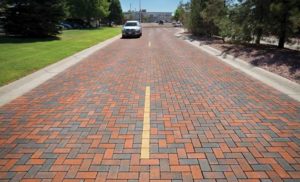
George Lacker III, president of GLC3 Concrete in Fort Lauderdale — a company whose moniker coincides with the initials of both the owner and “great-looking concrete” — has been in the concrete business for more than 30 years. Although his roots are firmly planted in the ordinary gray variety, his present and future involve extraordinary creations.
When he was only 16 years old, Lacker got his footing in the business back in Ohio, pouring industrial floors for Baker Concrete and learning the ropes from the boss himself. “Dan Baker was always so positive,” he remembers. “We’d complain we didn’t know how we’d get something done and he’d say, ‘You guys will figure it out.’” Then Baker would sit down and draw a diagram of the job, including little stick figures so the crew could see how many people were needed for the job and who would do what.

In 1980, Lacker moved to Florida, where most of his work still involved working with regular concrete. On the decorative front, he tinkered with rock salt finishes, colored concrete and a variety of exposed rock and shells, services he still offers today. However, in 1996 his whole direction began to change when he traveled to Oklahoma to stain his father-in-law’s floor. “That’s when I caught the bug,” Lacker recalls, referring to the fervor he felt about the acid-etch chemical staining process.
 He was gung-ho about chemical stains but the Floridians he encountered weren’t wild about the dark colors in his palette. Business floundered. Then in 1998, Lacker had the opportunity to hook up with Mike Miller, president of California-based The Concretist and a well-known consultant to the decorative concrete industry. Lacker had poured the floors for the Dolphin Mall in Miami and Miller was involved with the aesthetics of finishing them.
He was gung-ho about chemical stains but the Floridians he encountered weren’t wild about the dark colors in his palette. Business floundered. Then in 1998, Lacker had the opportunity to hook up with Mike Miller, president of California-based The Concretist and a well-known consultant to the decorative concrete industry. Lacker had poured the floors for the Dolphin Mall in Miami and Miller was involved with the aesthetics of finishing them.
“Mike is a concrete guru,” Lacker says about his now good friend, and he learned a lot from him during this initial encounter. With his confidence bolstered and some newfound knowledge about lighter colors under his belt, Lacker resigned from his job and went into business for himself.
“If you’re just getting started [in decorative concrete], the best advice I can give you is to find somebody who knows what they’re doing and become their friend,” says Lacker, who founded GLC3 in 1999. Probably the best venue for this is the World of Concrete, which attracts experts from everywhere, he adds. “It’s easier and more profitable to get people in different parts of the country to help you out than it is to get help from your competition.”
 In addition to establishing relationships with those in the know, he says, make sure you keep abreast with the industry by taking classes and attending seminars. This way you’ll not only keep up with the latest developments but you’ll learn the lingo customers expect to hear. “Architects want to hear the latest terminology,” he says, and speaking their language may help you land the job.
In addition to establishing relationships with those in the know, he says, make sure you keep abreast with the industry by taking classes and attending seminars. This way you’ll not only keep up with the latest developments but you’ll learn the lingo customers expect to hear. “Architects want to hear the latest terminology,” he says, and speaking their language may help you land the job.
And if there’s one thing he’s learned during these past 30-something years, it’s that samples will sell your work, too. “Whenever I give a seminar, I preach ‘sample, sample, sample,’” he says. Practice around the house. Try out new color combinations and designs. Do samples and set them outside to weather. “Practicing will let you see where you may have problems.” And it’s the best way to show clients what to expect.

“One of the biggest problems we have is that we haven’t educated the architects and general contractors about what can and cannot be achieved with acid staining. I’d say about 20 percent of them still don’t know that the colors in an acid wash are supposed to be inconsistent,” he says. They also don’t want to spend the extra money to protect the floors during the construction phase, and then they complain about spills and unwanted stains.

If the architect or GC wants consistency, he continues, they’d be better off with a polished integrally colored floor. “The color is a lot more consistent and the floor is more durable than acid stain.” If acid staining is the chosen method, be sure to let the clients know that a good maintenance program is key to keeping the floor looking good for years to come. “This can’t be stressed enough,” Lacker says.
|
|
|
Today and beyond
Lacker’s work today largely involves acid staining and polishing concrete floors for commercial establishments throughout Florida, including such big names as the Hard Rock Cafe in Hollywood, the Ritz-Carlton in West Palm Beach and Sloppy Joe’s in Key West.
Unusual requests are what he likes best. “If they can think it, we can produce it,” he says. “We like to do things that nobody’s done before,” adding that he creates many of his finishes using microtoppings with polymer-modified cement and a large dose of imagination.

Some of his best creations, he confesses, are developed when he’s just “fiddling around.” For instance, for one job, he spent hours preparing samples and then just threw one together for variety. “I threw some colors down, did a real fast trowel, threw another color down and sanded it. The second color filled in the voids left by the colors on the first trowel. It made a really unusual pattern and it was done really fast.” And that’s the one the customer picked.
 “Concrete is poetry,” he says, and you never know what will appeal to whom. “We’re creating something that wasn’t there before and we’re doing it any way we have to, with microtoppings, poured-in place, acid stain, integral and cast-on color. Bringing all these elements together can get complicated. But our goal is to be able to do the job as simply as possible and just have the results look complicated.”
“Concrete is poetry,” he says, and you never know what will appeal to whom. “We’re creating something that wasn’t there before and we’re doing it any way we have to, with microtoppings, poured-in place, acid stain, integral and cast-on color. Bringing all these elements together can get complicated. But our goal is to be able to do the job as simply as possible and just have the results look complicated.”
He says a lot of his business right now — and he anticipates much more in the future — involves floors that used to be tiled or carpeted. “That’s why we’re working to perfect a half-inch pour that can be stained or polished. We’re removing a half-inch of carpet and replacing it with concrete,” he says. He can even successfully pour concrete on top of a wood floor, a feat he’s proud to point out. “I can do it because I know how to cure the concrete.”
Don’t be afraid to try new things with concrete but always read the manufacturer’s instructions, Lacker advises, for a good basic understanding. And above all, learn from your mistakes because mistakes are going to happen. “You don’t get good at something without screwing something up,” he says. And experience pays. “I may not be the cheapest person to hire,” Lacker says, “but I’ve learned that people who don’t have the money to hire me in the beginning always have the money when it comes time to fix things that didn’t turn out right.”

















